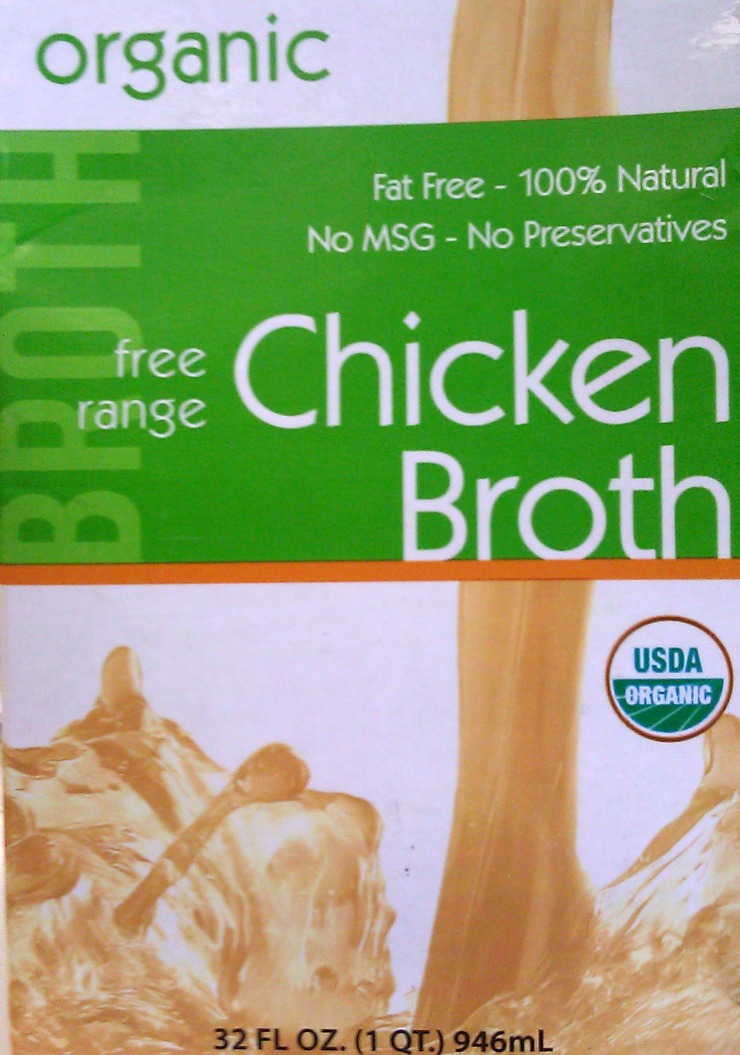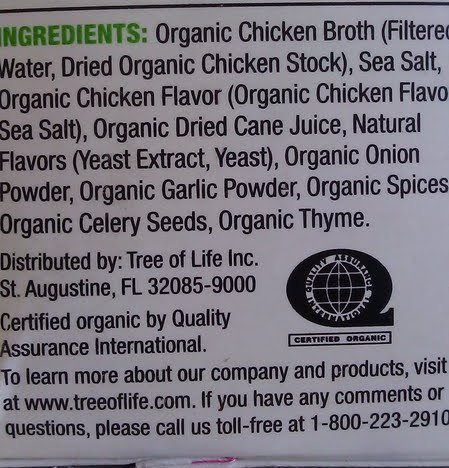Table of Contents[Hide][Show]
 Do you buy chicken broth labeled “No MSG” on the tetrapak or can from the store thinking this is a safe and healthy option for homemade soups you make at home?
Do you buy chicken broth labeled “No MSG” on the tetrapak or can from the store thinking this is a safe and healthy option for homemade soups you make at home?
Maybe you even go to the trouble and expense of buying chicken broth from the healthfood store that is labeled free range and organic believing this is a quality choice for your family.
Let’s dig into the label of these supposedly “no MSG”, “100% Natural” products and see what the real story is.
Are you ready for another Food Label Smackdown like the recent article shredding commercial coconut milk and almond milk in cartons?
Why You Must Avoid MSG
First, let’s take a brief moment to explain to any new readers why you must avoid MSG when you shop.
MSG is a dangerous neurotoxin that must be avoided as much as possible in your food. It kills neurons in the hypothalamus part of the brain stem that most likely never recover and are lost forever. The hypothalamus is the Master Controller of your endocrine system, so if you would like to have a healthy, balanced hormonal system, you must avoid MSG just like you avoid soy and BPA in your foods.
This goes for your children as well.
Mice fed MSG get morbidly obese. I truly believe, although I have not seen any studies on this yet, that the rampant use of MSG in processed foods plays a big role in the epidemic of fat and obese children in our society today.
Food manufacturers insist that MSG is natural because it is found naturally occurring in small amounts in some foods. When MSG is found in whole foods, however, it is bound to another molecule, usually protein and is therefore not able to cause neurological damage like the MSG that is freed from these molecules and present in large amounts in processed foods.
Products Labeled “No MSG” Usually Have MSG in Them
Once you realize just how dangerous MSG is to your neurological system and have resolved to avoid it, the next thing you must get your head around is the incredibly misleading, downright deceptive labeling of monosodium glutamate (MSG) in the United States today and probably elsewhere in the world.
Just because a product is labeled “no MSG” and is certified organic does not mean there is no MSG in it.
Huh? Say what?
 Let’s come at this from a different angle and more closely examine the organic chicken broth labeled “No MSG” pictured above. To the right is a picture of the ingredients label.
Let’s come at this from a different angle and more closely examine the organic chicken broth labeled “No MSG” pictured above. To the right is a picture of the ingredients label.
What is immediately apparent is that this product most definitely contains MSG due to the presence of Yeast Extract.
While the name “yeast extract” seems nonthreatening enough, it in fact always contains MSG and is a hidden source that very effectively fools consumers which is why it is a very popular label with manufacturers.
If you think about it, what in the world is “yeast extract” doing in chicken broth in the first place? Yeast is more used for baked goods, isn’t it? If you make chicken broth yourself at home, you don’t add any yeast. That would be completely ridiculous!
Why else would manufacturers be adding “yeast extract” to chicken broth except to synthetically enhance the flavor?
Another suspect ingredient in the label is “Organic Spices”. Another benign sounding name which most likely contains MSG.
If a spice mix is less than 50% MSG, food manufacturers don’t have to label the MSG at all!
Big Food is apparently allowed to pretend products they manufacture don’t contain any MSG when they very definitely do and even get away with trumpeting “NO MSG” on the front label of the product to catch the eye of wary consumers and fool them into purchasing their goods.
Since all chicken broth from the store, organic or not, contains MSG that I’ve ever seen, it is a MUST to learn how to make bone broth yourself at home. It is not hard to do and will do a world of good for the health of yourself and your family by introducing real nutrition to your homemade soups and sauces rather than synthetic and dangerous flavors and enhancers that will harm your brain and more than likely disrupt your hormones and metabolism.
In a report issued by General Foods in 1947, chemists predicted that the day would come when nearly all flavors, “natural” or not, would be chemically synthesized.
That day has long since arrived, so don’t be fooled by false and misleading advertising of broths, soups, and other goods labeled “No MSG” when the truth is, they are loaded with it.
Sarah, The Healthy Home Economist
More Information
Healthy and Easy Bouillon Cubes Recipe
Bone Broth and MSG: What You Need to Know
Headaches? MSG the Likely Cause
Stock or Broth? Are You Confused?








I appreciate your information..so many people do not realize how important it is to be careful what they eat. Most hyperactive children can be helped by an additive free diet and no meds are required…I knew this over 40 years ago and was a pioneer in the Feingold diet which eliminated chemicals and salicylates and the child returns to normal.. Just signed up for your newsletter and look forward always to knowing more. If any one of your readers is interested this this method there is a non-profit, parent group still operating. feingold.org. There is a lot of information and a chance to communicate with other parents having the same problems.
Hi Sarah,
I think you may be painting a broad stroke with yeast extract. There are various forms of glutamate not necessarily monosoduim glutamate in foods and our brain has receptors for them. They are not necessarily bad for you and obviously anything overly refined or in large quantities is toxic. Every substance in the universe is toxic. The thing with glutamate is that as it causes excitation of the brain receptors then people can easily be overstimulated casing flushing and headaches. Any excessive heat can cause the cells to metabolize to quickly and die. Just like getting angry heats the mind and also kills brain cells. Glutamate can pass through skin and cell barriers so are already being absorbed into the body as soon as you start eating it. Glutamate or Umami is the 5th flavour found in things like grilled or roasted meat and fish, kombu, shitake mushrooms, parmesan cheese, anchovies among others. The flavour is described as savory, yum, satisfying or nourishing. I would say all these foods have essential amino acids and many are high in B vitamins. Evolutionary speaking our bodies do crave these things and we have receptors to tell us when we have had too much. In small natural quantities I would say they are very good for health however refined like any food they they are overly readily available much more so than our bodies can handle. As far as diabetes they may be responsible to overstimulate the ghrelin receptors, causing inefficacy of the receptors in turn needing more ghrelin hormone to feel full. This would cause people to generally eat more before feeling full. This is just me speculating. MSG is much like salt and is overly pervasive in our prepared foods today. Although salt is very important for the ionization balance of our bodies so that cells and nerves may communicate properly. Glutamate may also affect the communication in the brain and nerves. The key thing here is over excitation creates heat which in tern destroys cells so limiting intake is good. You may be safer eating these foods if you are from a colder climate. People in cold climate may require more energy, as their metabolism is slowed down by the temperature. This is why people in cold climates hit puberty 1-2 years later than warm countries and also have longer life expectancy.
Are there any consommé, chicken, or bone broths that do not contain MSG? If so, please recommend. Thank you!
Yes, here is what I buy and contains no MSG. It’s listed on my resources page. https://www.thehealthyhomeeconomist.com/resources/#8
what about “natural chicken flavor” or “organic spices”…the IMAGINE brand organic, free range, and states “no added MSG” makes me nervous..
Stay away! Organic spices can be MSG in disguise. Organic MSG is still unsafe.
MSG is a naturally occurring salt. This article is misinformation that makes Russians look like amateurs. Please cite scientific evidence to back up your assertions. Lot of the studies regarding MSG have been debunked. If you stuff a mouse with table salt you will kill it. Yet we eat it. Garbage article.
I suggest you read the book “Exitoxins” written by a neurologist. There is HUGE difference between naturally occurring glutamate (an amino acid by the way) and the factory synthetized version known as MSG.
Thank you, I wish I had read this article before I drank a cup of Kitchen Basics No MSG Chicken Broth yesterday. I’m on my second day of a bad headache after that mistake. If one wishes to point out that MSG is natural, that’s fine, but I would guess that they don’t suffer from migraines triggered by obviously UNNATURAL AMOUNTS of MSG in their food. Products with unnatural amounts of MSG become obvious very quickly to a person that is aware of their adverse reaction to it.
Thank you for this article. I recently found a new bone broth sold at health food stores called “Epic Artisanal bone broth”. The chicken broth ingredients are… filtered water, organic chicken, onions, celery, carrots, sea salt, garlic, apple cider vinegar, lactic acid, rosemary, and tumeric. Have you heard of this product and if so what do you think of it? Thank you.
It’s fine (if it’s the one in glass jars). However, be aware that ALL store bought bone broths are watered down. Put them in the refrigerator and they don’t gel like homemade does.
Per P Sawyer on another site:
MSG is the sodium salt of glutamic acid, a naturally occurring amino acid present in just about every protein, whether animal or vegetable. As protein breaks down (commonly via hydrolysis) glutamate radicals are released. If this does not happen during the manufacturing process, it will happen in your body as you digest the protein. Once the glutamate radical meets up with a sodium ion (your body contains lots of salt), you get MSG.
We can debate concentration levels, and speed of absorption, but if it contains chicken or beef, it contains “hidden” MSG.